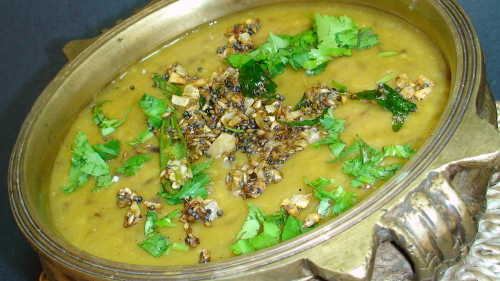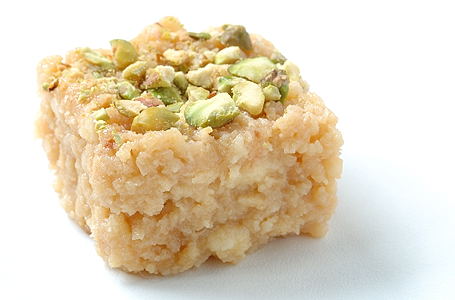I was watching an episode of his where he travelled to Rajasthan (in India) What really stuck in my mind was what the Prince of Udaipur said. He said that the concept of non-stick pan doesn't exist in Indian cooking. Burning is pretty much part of the flavour. That set me thinking and wondering if it was really true. Turns out he's pretty much right. India despite its huge diversity in food habits has this common thread of an added flavour due to getting a little burnt.
The best example is the dal served part of any meal (south or north). Tadka that is added to the dal (lentils) is pretty nothing but a mixture of spices in a little bit of oil, burnt in a small deep spatula to give that distinct taste. Punjabi tadka is sometimes intentionally burnt a little extra to give that smoky taste that goes well with roti and paneer.
 |
| The garnishing is the tadka which is a slightly burnt mixture of several spices. yummm :D |
One example from south Indian cuisine is the shallow fried dry vegetable curry. The telugu guy that I am, I call it vepudu (fry). Bhindi fry is really popular in this part of the India and I'm in love with it. The kind of texture and taste that Lady's Finger gets is only because of the slight burning that happens in during shallow frying.
Dosa, roti, tandoori roti and naan all are cooked directly over fire. Ok, maybe not dosa but some varieties are. All these have small patches where the batter is slightly burnt and they add a distinct flavour which can't be achieved using a non-stick pan. So much so that, most people even today stick to the centuries old tandoor for making tandoori roti inspite of the mass proliferation of ovens and grills.
 |
| Ajmeri Kalakhand. One of the my fav sweets! |
The most surprising thing is that there are many sweets which taste the way they taste because of burning. All variants of kalakhand are prepared after intense boiling of milk. Boiling it to a point that most of the water escapes and the solid remains start burning. The burnt part forms a layer sticking to the vessel while the rest of the remains are taken for preparing the sweet. Interestingly, the part that was burnt is further burnt and eaten with rice in south India. Also, Gulab jamun tastes the way it does because the recipe asks us to let it be deep fried in oil for a moment longer to give that blackish-maroon color. Another example of burning it slightly.
These are the dishes that I can remember off my head. I'm sure there are many more and occasional peeks in the kitchen while my mom is making something would reveal a dozen more dishes which are prepared this way. The only downside of this activity is use of liberal amounts of oil which often make food heavy and full of cholesterol. This has always been true for India. However, it was not a problem a few decades or centuries back (All the dishes discussed here date back many centuries back :P) due to physical activities being an integral part of daily life. However, we modern Indians, as we embrace services culture and welcome sedentry lifestyle with open hands, we must also be cautious of how much food we eat. It's difficult to exercise control therefore one should involve oneself in physical activities. I walk a lot. What do you do?


No comments:
Post a Comment